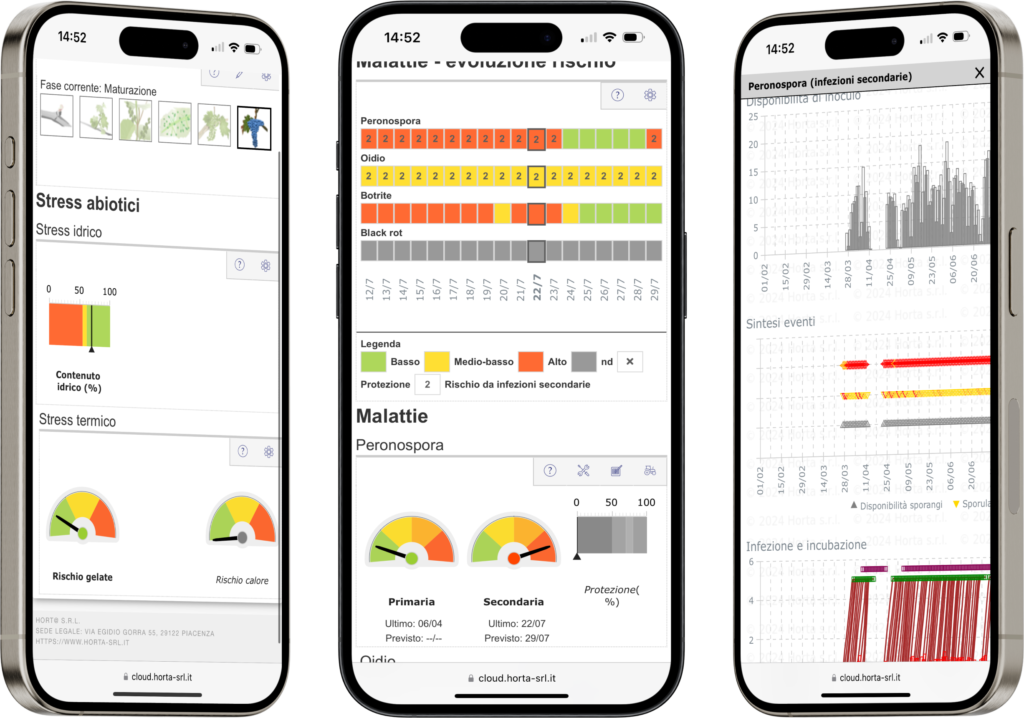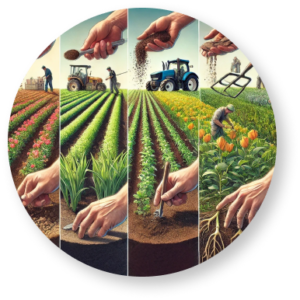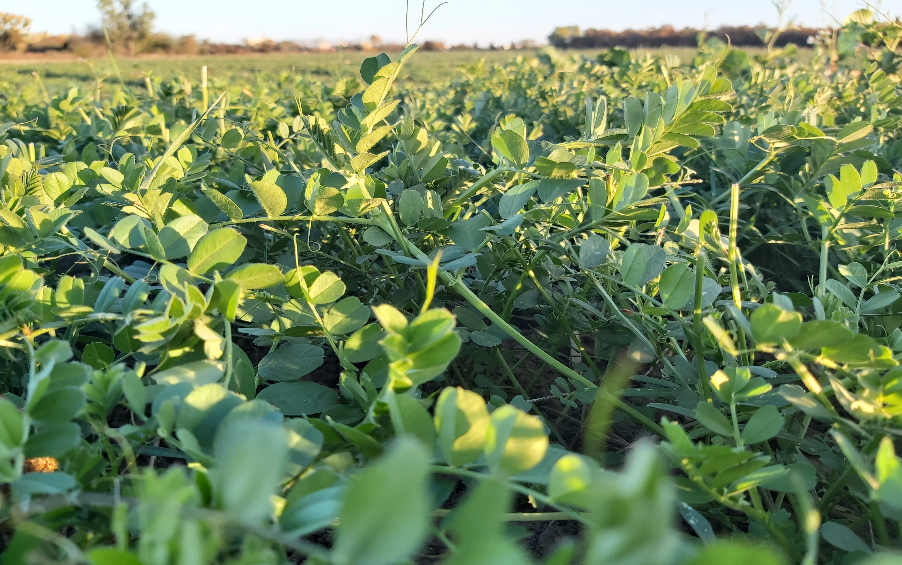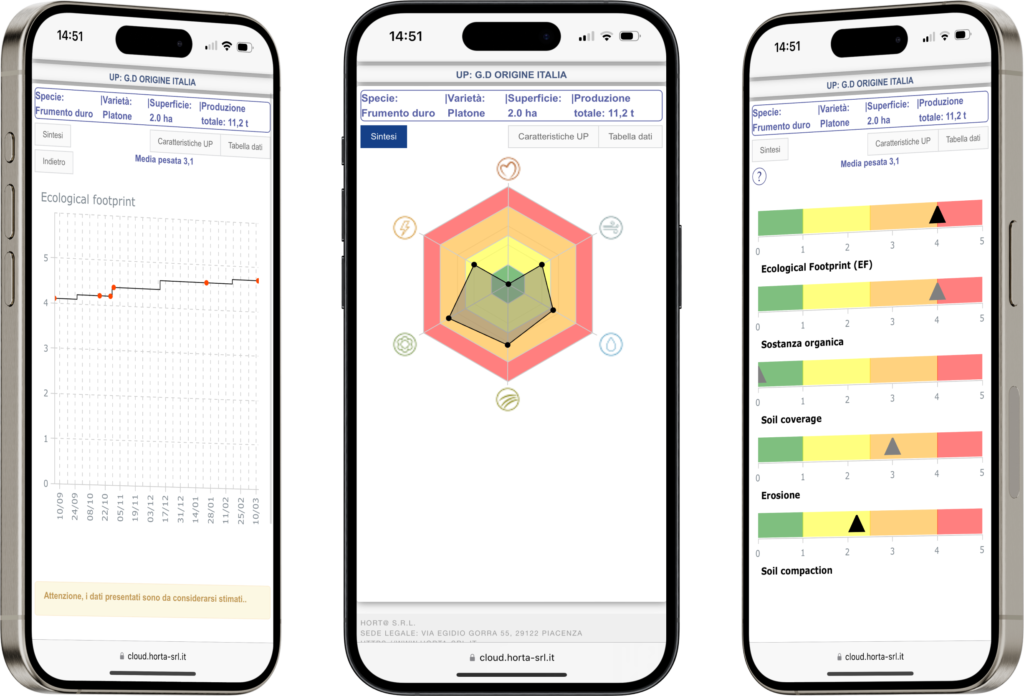Pathways towards zero-carbon agricultural systems, preventing negative impacts on biodiversity and ecosystems.
Our extensive field experience, alongside public and private companies, organizations, and communities, has allowed us to test and develop innovative practices in various settings and conditions. Today, our mission is clear: to promote sustainable practices for agri-food supply chains, aimed at decarbonization and the restoration of global biodiversity.
What are the main challenges facing agri-food supply chains today?
- Soil Fertility Decline: Issues related to the excessive use of chemical fertilizers and pesticides.
- Ineffective Resource Management: Challenges in real-time monitoring of soil and crop conditions.
- Climate Change: Negative impacts on agricultural productivity due to extreme weather events.
- Economic Pressure: The need to maintain profitability while adopting more sustainable practices.
What are Horta's solutions?
- Identification of Best Practices: Our agronomists work with agri-food supply chains to identify the most effective and sustainable agricultural practices, enabling farmers to achieve both short- and long-term strategic goals.
- Due Diligence and Feasibility Studies: We support food companies in evaluating and implementing regenerative agriculture practices, reducing the use of chemical inputs and improving soil health.
- Cost and Emission Analysis: We continuously monitor actions taken in the fields, providing precise data on costs and emissions to optimize agricultural operations.
- Holistic Approach with DSS: Our Decision Support System (DSS) guides agri-food supply chains throughout the entire transition process towards more sustainable agriculture, providing real-time data and insights.
- Ongoing Training Programs: We ensure that farmers have access to continuous training, making sure they are never alone in their transition to more sustainable practices.

Are you interested in working with us in carbon farming? Get more information about our MRV tools and open programs!
One of the key drivers for achieving carbon neutrality is investing in regenerative agriculture, as climate change is no longer a distant threat.
Combating the climate crisis with practices that sequester more carbon in the soil and make farmland more resilient is a priority. Regenerative agriculture enhances the long-term livelihood of farmers in various ways:
- by improving soil health
- by increasing organic and inorganic carbon in the soil in the form of organic matter
- by preserving and enhancing biodiversity and reducing the risk of erosion.
All of this is achieved while reducing greenhouse gas emissions and maintaining the profitability of farms.

What sets us apart from the rest?

Expertise and Flexibility
The expertise and flexibility of our team allow us to be involved at all levels of the agri-food supply chain, from the field to the consumer’s table.

Ongoing support for agri-food supply chains
We support agri-food supply chains in introducing a wide range of regenerative agricultural practices.
The promoted practices have been tested over the last decade in our field trials, with the aim of refining techniques and recommending precise actions and practical suggestions to increase the chances of success.

Synergistic Action
The synergistic action of DSS and regenerative practices is helping to ensure multiple co-benefits, including increased soil fertility and biodiversity, reduced greenhouse gas emissions in the field, and improved water quality.
The Role of Cover Crops in Regenerative Agriculture
Cover crops, also known as catch crops or non-revenue crops, are sown between seasonal crops intended for sale. These agricultural practices represent a key solution to many of the challenges that farmers face today.
Farmers face multiple challenges, including high greenhouse gas emissions, declining soil fertility, nutrient leaching, poor drainage, erosion, weed infestation, declining pollinator populations, insufficient forage, and unfavorable soil conditions such as salinity or degradation—all of which reduce productivity and long-term sustainability.

Cover crops
Cover crops offer numerous agronomic benefits, which can be classified into 10 main effects:
- Reduction of Greenhouse Gas Emissions: Directly or Indirectly.
- Increase in Soil Biomass: Enhances Carbon Reserves.
- Limitation of Nitrogen Leaching: Preserves Nutrients in the Soil.
- Improvement of Soil Drainage: Facilitates Water Percolation.
- Improvement of Soil Structure: Enhances Soil Stability and Health.
- Erosion Risk Control: Protects the Soil from Erosion.
- Weed Competition Reduction: Decreases Weed Growth.
- Pollinator Support: Provides Habitat and Resources.
- Forage Production: Provides Food for Livestock.
- Tolerance to Saline Soils: Enables Cultivation in Challenging Conditions.
Horta's experience with cover crops is extensive. Over the past decade, field trials have allowed us to build a solid foundation on dozens of species.
For example, relay cropping/intercropping trials are one of the most interesting strategies, where the cover crop is sown into the main crop before its harvest, helping to better understand the interaction between the cover crop and the main crops.
Cover crops accumulate organic carbon as organic matter in the soil, which, depending on soil and climatic conditions, will gradually be stored in the soil as stable humus or mineralized, releasing nutrients for subsequent crops.
Quantifying these rates is crucial; Horta assesses how soil and climatic conditions influence the decomposition of these two forms, integrating key data from cover crop trials into carbon farming protocols.
Support for Cover Crops
**Do you need support in understanding how to best integrate cover crops into your cropping cycle?**
Consumers are demanding that agricultural systems make greater efforts to counter the ongoing decline in biodiversity across Europe.
Intensive use of agricultural land, particularly monoculture systems with heavy inputs of fertilizers and pesticides, can drive the degradation of biodiversity and landscapes, especially in regions with limited agro-ecological areas between agricultural lands.
Sustainable agriculture requires simple calculators to understand how agricultural activities impact biodiversity and to highlight the importance of agro-ecological measures applied by farmers. These tools provide crucial information to guide conservation actions.
However, assessing biodiversity based on the total number of distinct species within a local community is a time-consuming approach with poor scalability.

Indirect assessment of biodiversity is a solution, and Horta focuses on this approach by analyzing ecosystem change factors.
Carbon Farming and Carbon Credits
A carbon credit is a certified and tradable metric equivalent to one ton of carbon dioxide (CO2). In agriculture, the cultivation system is responsible for CO2 emissions into the atmosphere, arising from inputs used during cultivation (e.g., fuel, fertilizers, energy consumption) and CO2 released from the mineralization of organic compounds in the soil (e.g., crop residues, organic fertilizers).
At the same time, effective carbon capture in the soil and agricultural practices, such as regenerative agriculture, sequester CO2 from the air, increasing the stable storage of carbon in the soil (i.e., removals).

Reduction of Emissions

Carbon Sequestration
Agri-food companies face various challenges related to sustainability and productivity. CO2 emissions into the atmosphere increase environmental impact and significantly contribute to climate change. Additionally, poor carbon capture in the soil reduces the potential for CO2 sequestration, compromising soil fertility and its ability to support healthy crops. Dependence on chemical inputs, such as fertilizers and pesticides, not only raises operational costs but also increases greenhouse gas emissions, further exacerbating the environmental impact.
Carbon credits originate from the removals plus reductions in emissions from the cultivation system compared to a baseline. Efforts by agri-food supply chains and agricultural businesses in removing CO2 from the air can be rewarded with carbon credits if they meet the criteria of being real, permanent, attributable, and additional compared to the common scenario (i.e., conventional practices). In carbon farming programs, agri-food supply chains follow Horta's Monitoring, Reporting, and Verification (MRV) program over a period of ten/five years. Our approach involves calculating removals using an internally developed process-based model, validated for soil carbon and nitrogen dynamics over months and seasons, primarily by:
- Type and Quantity of Plant Biomass Added to the Soil through Cultivation
- Carbon Content of Plant Biomass
- Amount of Carbon Released from Organic and Organo-Mineral Fertilizations
- Duration of Live Crops and/or Cover Crops on the Land

Validated Model for Mediterranean Areas
All procedures are automated, and algorithms quantify carbon based on soil type, temperature, moisture, and the presence or absence of plants.
The model, validated and calibrated for Mediterranean areas, highlights the benefits generated by each regenerative practice implemented in the fields, allowing for the accounting of reduced or removed carbon credits.
Ongoing training programs on regenerative agriculture are consistently scheduled throughout the year, ensuring that agri-food supply chains are never left behind.
Ongoing Projects
Ongoing projects, generally promoted by agri-food companies or certification bodies, use carbon insetting and offsetting to reduce carbon emissions and achieve carbon neutrality.
A specific design for each company is crucial, as each company is different from the others. Only by considering the pedo-climatic characteristics, the company’s funding profile, and the local context can cropping systems be redesigned with a focus on carbon farming.


Regenerative Practices for Cropped Fields and Orchards
The main regenerative practices promoted by Horta for cropped fields or orchards are:
- Maximize soil cover with cover crops/catch crops/green manure
- Keep plant residues "in situ"
- Minimize soil disturbance with minimal or no tillage.
- Diversify crop rotation (3/4-year rotation).
- Integrate legumes into rotations (e.g., chickpeas, lentils, peas, etc.).
- Encourage the use of organic amendments/biochar.
- Integrate agroforestry.
Regenerative Practices for Tree Crops
The main regenerative practices promoted by Horta for tree crops are:
- Maximize soil cover with cover crops/catch crops/green manure
- Maintain plant residues "in situ"
- Minimize soil disturbance with minimal or no tillage
- Encourage the use of organic amendments/biochar

Explore Horta's MRV program and the measurement of the benefits of actions on soil organic carbon in agri-food supply chains!
The impact of strategies adopted to regenerate degraded soil and reduce emissions in agricultural practices will be closely monitored through a series of KPIs calculated with our tool, yousustain.net.
Metrics such as Carbon Footprint and Climate Change (including fossil, biogenic emissions, and land use) measured in tons of CO2eq per ton of crop help quantify the carbon reduction achieved through optimized agricultural input use compared to conventional methods.

Agri-food supply chains can tackle this challenge with the aid of Decision Support Systems (DSS), which enable the reduction of greenhouse gas emissions and enhance the sustainability of agricultural operations, making the adopted practices more efficient and sustainable.
Contact us to learn how to buy or sell carbon credits derived from Horta's programs.
Monitoring Co-Benefits in Carbon Farming Programs

Ecosystem Services
Biodiversity

Ecosystem Services
Soil Health
Consumers are demanding greater efforts from agricultural systems to address the ongoing decline in biodiversity across Europe.
Horta is involved in various research projects on ecosystem services and results-based payment systems for biodiversity conservation in agricultural lands, monitoring erosion risk, and restoring soil health.
Regenerative practices should promote climate actions with the potential to bring climate adaptation as well as environmental and socio-economic co-benefits, such as biodiversity conservation, water quality, and soil erosion reduction.
For biodiversity, Horta has implemented an indirect assessment based on the ecotoxic properties of pesticides applied in cultivation systems, working with the properties of active ingredients, environmental fate, ecotoxicology (terrestrial, aquatic), and toxicity parameters for human health. Risk assessment is integrated with mitigation measures implemented to reduce exposure, providing a comprehensive risk assessment.
Other tools and methodologies aim to support soil functions and ecosystem services, and a decision support system guides agri-food chains in soil management through four simple steps:
- On-site identification of specific soil and environmental issues
- Identification of the best soil management techniques to mitigate identified issues
- Implementation of techniques in specific business situations
- Self-assessment of results after implementing the chosen solutions.
Looking to the future, carbon farming and carbon credits represent a new frontier for our collaborations. These practices not only help offset emissions but also open up new market opportunities.


